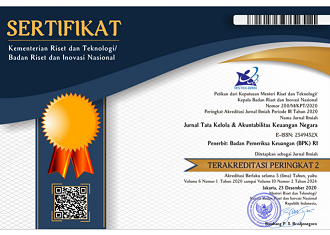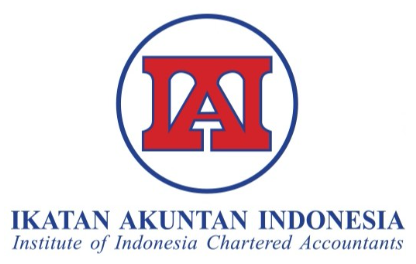FACTORS AFFECTING INTENTION ON WHISTLEBLOWING: AN ANALYSIS ON MODERATED MODEL OF WHISTLEBLOWING CHANNEL
DOI:
https://doi.org/10.28986/jtaken.v4i2.218Keywords:
personal responsibility, personal cost, education, whistleblowing channel, intention on whistleblowingAbstract
The purpose of this study is to examine and to provide empirical evidence of the effect of personal responsibility, personal cost, and education on whistleblowing intention, as well as the impact of whistleblowing channel in influencing personal cost on whistleblowing intention. The populations of this study are civil servants (ASN) from the financial department and procurement services department in Banjarmasin municipal government. The sample of this study is 104 respondents, obtained using the saturated sampling technique. Questionnaire data of this research is analyzed using the Partial Least Squares (PLS). The result shows that civil servants consider their personal responsibility as they intend to blow the whistle. Yet, the study finds that personal cost and education do not affect civil servant's whistleblowing intentions. The study also finds that the whistleblowing channel is unable to moderate the effect of personal cost on whistleblowing intention. These findings help to obtain insight regarding the policy that can improve whistleblowing intention.
References
Ajzen, I. (1991). The theory of planned behavior. Organizational Behaviour and Human Decision Process, 50, 179-211.
Alleyne, P., Hudaib, M., & Pike, R. (2013). Toward a conceptual model of whistleblowing intentions among external auditors. The British Accounting Review, 45, 10-23.
Alleyne, P., Soverall, W. C, Broome, T., & Pierce, A. (2017). Perceptions, predictors, and consequences of whistleblowing among accounting employees in Barbados. Meditary Accountancy Research, 25(2), 241- 267.
Andrade, J. A. (2015). Reconceptualising Whistleblowing in a Complex World. Journal of Business Ethics, 128, 321-335.
Arikunto, S. (2012). Prosedur Penelitian Suatu Pendekatan Praktek. Jakarta: Rineka Cipta.
Ayers, S., & Kaplan, S. E. (2005). Wrongdoing by Consultants: An Examination of Employees Reporting Intentions. Journal of Business Ethics, 57, 121-137.
Bandura, A. (1971). Social Learning Theory. New York: General Learning Press.
Basri, S. A., Marsam, A. D., Majid, R. A., Abu, N. A., & Mohamed, N. (2017). Reinforcement tool of whistleblowing to eradicate fraud in the public sector. SHS Web of Conference, 36, 1-6.
Batson, C. D. (2011). A history of prosocial behavior research. Handbook of the History of Social Psychology. Routledge.
Berry, B. (2004). Organizational culture: a framework and strategies for facilitating employee whistleblowing. Employee Responsibilities and Rights Journal, 16(1), 1-11.
Bhal, K. T., & Dadhich, A. (2011). Impact of ethical leadership and leader-member exchange on whistleblowing: The moderating impact of the moral intensity of the issue. Journal of Business Ethics, 103, 485-496.
Brewer, G. A., & Selden, S. C. (1998). Whistleblowers in the federal civil service: New evidence of the public service ethic.
Journal of Public Administration Research and Theory, 8, 413-440.
Caillier, J. G. (2017). An examination of the role whistle-blowing education plays in the whistle-blowing process. The Social Science Journal, 54, 4-12.
Cavanagh, G. F., Moberg, D. J. & Velasquez, M. (1981). The ethics of organizational politics. Academy of Management Review, 6(3), 363-374.
Cho, Y. J., & Song, H. J. (2015). Determinants of whistleblowing within government agencies. Public Personnel Management, 44(4), 450- 472.
Curtis, M. B., (2006). Are audit-related ethical decisions dependent upon mood?. Journal of Business Ethics, 68(2), 191-209.
Chiu, R. K. (2002). Ethical judgment, locus of control, and whistleblowing intention: A case study of Mainland Chinese MBA students. Journal of Business Ethics, 43(1), 65-74.
Dozier, J. B., & Miceli, M. P. (1985). Potential predictors of whistleblowing: A prosocial behavior perspective. Academy of Management Review, 10(4):823-836.
Eisenberg, N., & Mussen, P. H. (1989). The Roots of Prosocial Behavior in Children. Britania Raya: Cambridge University Press.
Frisque, D., & Kolb, J. (2008). The effects of an ethics training program on attitude, knowledge, and transfer of training of office professional: A treatment and control-group design. Human Resource Development Quarterly, 19, 35-53.
Gao, J., Greenberg, R., & Wong-On-Wing, B. (2015). Whistleblowing intentions of lower-level employees: The effect of reporting channel, bystanders, and wrongdoer power status. Journal of Business Ethics, 126, 85-99.
Gao, L., & Brink, A. G. (2017). Whistleblowing studies in accounting research: A review of experimental studies on the determinants of whistleblowing. Journal of Accounting Literature, 38, 1-13.
Government Regulation Number 11 of 2017 on Civil Service Management.
Ghani, N. A., Galbreath, J., & Evans, R. (2013). Predicting whistle-blowing intention among supervisors in Malaysia. Journal of Global Management, 3(1), 1-18.
Graham, J. W. (1986). Principled organizational dissent: a theoretical essay. In B. M. Staw, & L. L. Cummings (Eds.), Research in organizational behavior, 8, 1-52.
Greenwich, CT: JAI. Hakim, T. I. R (2017). Pengaruh faktorfaktor multidimensional terhadap niat melakukan whistleblowing dengan whistleblowing channel sebagai variabel moderasi (Studi pada KPP pratama Malang Utara dan Kepanjen). (Tesis) Program Magister Akuntansi Universitas Brawijaya, Malang.
Hartono, J., & Abdillah, W. (2015). Partial Least Square (PLS) alternatif Structural Equation Modelling (SEM) dalam Penelitian Bisnis. Yogyakarta: Penerbit Andi.
Hersh, M. A. (2002). Whistleblowers heroes or traitors?: Individual active responsibility for ethical behavior. Annual Reviews in Control, 26, 243-262.
Hofstede, G. (1980). Culture's consequences: International differences in work-related values. California: Sage Publication.
Hooks, K. L., Kaplan, S. E., & Schultz Jnr, J.J. (1994). Enhancing communication to assist in fraud prevention and detection. Auditing: A Journal of Practice & Theory, 13(2), 86-117.
Iskandar, A., & Saragih, R. (2018). Pengaruh sikap ke arah perilaku, norma subjektif dan persepsi kontrol atas perilaku terhadap niat dan perilaku whistleblowing CPNS. Jurnal Tata Kelola dan Akuntabilitas Keuangan Negara, 4(1), 63-84.
Jarvis, P., Holford, J. & Griffin, C. (2003). The theory and practice of learning. Second edition. Great Britain and the United States: Kogan Page Limited.
Kaplan, S. E., Pany, K., Samuels, J., & Zhang, J. (2012). An examination of anonymous and nonanonymous fraud reporting channels. Advances in Accounting, 28 (1), 88-95. doi: 10.1016/j.adiac.2012.02.008.
Kaplan, S. E., & Whitecotton, S. M. (2001). An examination of auditor's reporting Intentions when another auditor is offered client employment. Auditing Journal of Practice & Theory, 20(1), 45-63. doi: 10.2308/aud.2001.20.1. 45.
Karatuna, I., & Basol, O. (2018). To blow the whistle or not: The roles of perceived organizational retaliation and upward communication satisfaction in employee responses to observing wrongdoing. Redefining Corporate Social Responsibility, 13, 217-233.
Kuncara, A., Furqorina, R., & Payamta. (2017). Determinants of internal whistleblowing intentions in the public sector: Evidence from Indonesia. SHS Web of Conference, 34, 1-9. doi: doi.org/10.1051/shsconf/ 20173401002.
Latan, H., Ringle, C. M., & Jabbour, C. J. C. (2018). Whistleblowing intention among public accountants in Indonesia: Testing for the moderation effects. Journal of Business Ethics, 152(2), 573-588.
Leeds, R. (1963). Altruism and the norm of giving. Merrill-Palmer Quarterly of Behavior and Development, 9(3), 229-240.
Mannion, R., & Davies, H. T. (2015). Cultures of silence and cultures of voice: The role of whistleblowing in healthcare organizations. International Journal of Health Policy Management, 4(8), 503-505.
Meikhati, E., & Rahayu, I. (2015). Peranan audit internal dan pencegahan fraud dalam menunjang efektivitas pengendalian internal (studi kasus pada Yayasan Internusa Surakarta). Jurnal Paradigma, 13(1), 77-91.
Meng, T. P., & Fook, O. S. (2011). Comparative analysis of whistleblower protection legislations in England, USA, and Malaysia. African Journal of Business Management, 5(27), 11246-11255. doi: 10.5897/AJBM11.1332.
Mesmer-Magnus, J. R., & Viswesvaran, C. (2005). Whistleblowing in organizations: an examination of correlates of whistleblowing intentions, actions, and retaliation. Journal of Business Ethics, 62 (3), 277-297.
Miceli, M. P., & Near, J.P. (1985). Characteristics of organizational climate and perceived wrongdoing associated with whistleblowing decisions. Personnel Psychology, 38, 525-544. doi: 10.1111/j.1744- 6570.1985.tb00558.x .
Miceli, M. P., Near, J. P., & Dworkin, T. M. (2008). Whistleblowing in organizations. New York, NY: Routledge.
Miceli, M. P., Near, J. P., & Schwenk, C. R. (1991). Who blows the whistle and why?. Industrial and Labor Relations Review, 45(1), 113-130.
Mitchell, A., & Sikka, P. (2004). Accountability of the accounting bodies: the peculiarities of a British accountancy body. British Accounting Review, 36, 395-414.
Nayir, D. Z., & Herzig, C. (2012). Value orientations as determinants of preference for external and anonymous whistleblowing. Journal of Business Ethics, 107(2), 197-213.
Near, J. P., & Miceli, M. (2016). After the wrongdoing: What managers should know about whistleblowing. Business Horizons, 59(1), 105-114. doi: 10.1016/j.bushor.2015.09.007.
Nurhidayat, I., & Kusumasari, B. (2018). Strengthening the effectiveness of whistleblowing system: A study for the implementation of anti-corruption policy in Indonesia. Journal of Financial Crime, 25(1), 140-154.
Park, H., Rehg, M. T., & Lee, D. (2005). The influence of Confucian ethics collectivism on whistleblowing intentions: A study of South Korean public employees. Journal of Business Ethics, 58(4), 387-403.
Park, H., Blenkinsopp, J., Oktem, M. K., & Omurgonulsen, U. (2008). Cultural orientation and attitudes toward different forms of whistleblowing: A comparison of South Korea, Turkey, and the U.K. Journal of Business Ethics, 82(4), 929-939.
Robinson, S. N, Robertson, J. C., & Curtis, M. B. (2012). The effects of contextual and wrongdoing attribute on organizational employees whistleblowing intentions following the fraud. Journal of Business Ethics, 106(2), 213-227.
Schultz, J. J., Johnson, D. A., Morris, D., & Dyrnes, S. (1993). An investigation of the reporting of questionable acts in an international setting. Journal of Accounting Research, 31, 75-103. doi: 10.2307/2491165.
Sekerka, L. E., Bagozzi, R., & Charnigo, R. (2009). Facing ethical challenges in the workplace: Conceptualizing and measuring professional moral courage. Journal of Business Ethics, 89(4), 565-579.
Semendawai, A. H., Santoso, F., Wagiman, W., Omas, B. I., Susilaningtias, Wiryawan, S. M. (2011). Memahami whistleblower. Jakarta Pusat: Lembaga Perlindungan Saksi dan Korban (LPSK).
Septianti, W. (2013). Pengaruh faktor organisasional, individual, situasional, dan demografis terhadap niat melakukan whistleblowing internal. Simposium Nasional Akuntansi XVI, Manado.
Sheler, J. L. (1981). When employees squeal at fellow workers. US News & World Report, 16, 81-82.
Sholihin, M., & Ratmono, D. (2013). Analisis SEM-PLS dengan WarpPLS 3.0. Yogyakarta: Penerbit Andi.
Sina, L. (2008). Dampak dan upaya pemberantasan serta pengawasan korupsi di Indonesia. Jurnal Hukum Pro Justitia, 26(1), 39-51.
Stead, W. E., Worrell, D. L., & Stead, J. G. (1990). An integrative model for understanding and managing ethical behavior in business organizations. Journal of Business Ethics, 9(3), 233- 242.
Suratno (2017). Perlindungan hukum Saksi dan korban sebagai whistleblower dan justice collaborators pada pengungkapan kasus korupsi berbasis nilai keadilan. Jurnal Pembaharuan Hukum, 4(1), 130-139.
Terzi, A. R. (2011), Relationship between power distance and autocratic democratic tendencies. Educational Research and Reviews, 6(7), 528- 535.
The Hofstede-Insights. (2018). Country comparison. Retrieved from https:// www.hofstede-insights.com/countrycomparison/indonesia/.
Transparancy International. (2016). Corruption Perception Index. Retrieved from https://ti.or.id/wpcontent/uploads/2017/04/ corruption perception index 2016 design. pdf-2.pdf.
Tsui, J. & Windsor, C. (2001). Some cross-cultural evidence on ethical Reasoning. Journal of Business Ethics, 31(2), 143-150.
Widyastuti, A. R. (2015). Disfungsional birokrasi sebagai kendala dalam pemberantasan korupsi. Yustisia, 4 (3), 108-117.
Young, R. F. (2017). Blowing the whistle: Individual persuasion under the perceived threat of retaliation. Behavioral Research in Accounting, 29(2), 97-111.
Zhuang, J. (2003). Whistle-blowing and peer reporting: A cross-cultural comparison of Canadians and Chinese. (Thesis). Magister Ilmu Manajemen, Universitas Lethbridge, Alberta, Kanada.
Downloads
Submitted
Accepted
Published
How to Cite
Issue
Section
License

Jurnal Tata Kelola dan Akuntabilitas Keuangan Negara is licensed under
a Creative Commons Attribution-ShareAlike 4.0 International License




















